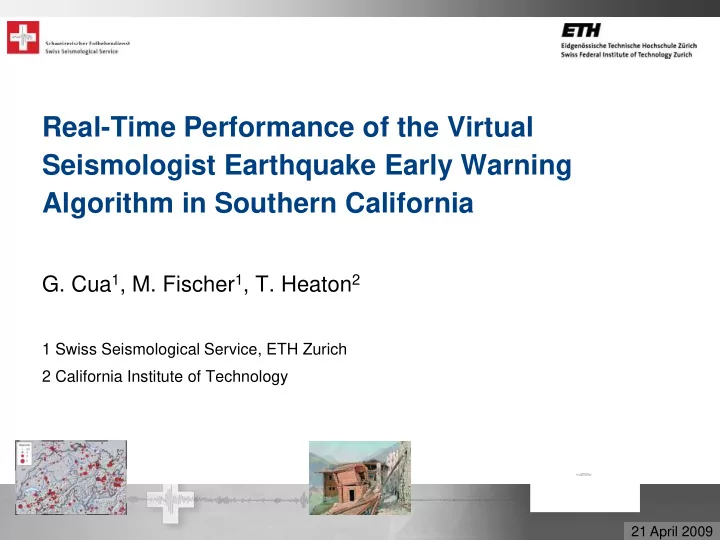

Real-Time Performance of the Virtual Seismologist Earthquake Early Warning Algorithm in Southern California G. Cua 1 , M. Fischer 1 , T. Heaton 2 1 Swiss Seismological Service, ETH Zurich 2 California Institute of Technology QuickTime™ and a TIFF (Uncompressed) decompressor are needed to see this picture. 21 April 2009 10/4/07
Outline Description of VS algorithm (Bayes’ theorem in EEW) Implementation of likelihood function Challenges of operating in real-time (with noise) Some performance statistics (13 July 2008 - 9 April 2009) Conclusions and Outlook 21 April 2009 10/4/07
Virtual Seismologist EEW algorithm (Cua and Heaton) • regional, network-based Bayesian approach to EEW • quantifying “back of the envelope” methods of human seismologists • implemented by ETH through SAFER • real-time testing and performance evaluation through CISN EEW project • real-time in Southern California since 13 July 2008 • coming soon to Northern California and Switzerland Bayes’ Theorem in EEW Given the available set of observations (picks and amplitudes), the most probable source characterization is given by prob ( M , lat , lon | obs ) prob ( obs | M , lat , lon ) prob ( M , lat , lon ) Prior (“other” information) Posterior (“answer”) Likelihood (“data”) 21 April 2009 10/4/07
Virtual Seismologist (VS) EEW algorithm (Cua and Heaton) Regional, networ-based Bayesian approach to EEW for regions with distributed seismic hazard/risk Modeled on “back of the envelope” methods of human seismologists for examining waveform data Shape of envelopes, relative frequency content Capacity to assimilate different types of information Previously observed seismicity State of health of seismic network Known fault locations Gutenberg-Richter recurrence relationship 10/4/07
VS likelihood function P-S discriminant Estimating M from ground motion ratio Envelope attenuation relationships 21 April 2009 10/4/07
VS likelihood function P-S discriminant Estimating M from ground motion ratio Envelope attenuation relationships P-wave frequency content scales with M (Nakamura, 1986; Allen and Kanamori,2003) Single station magnitude estimate 21 April 2009 10/4/07
VS likelihood function P-S discriminant Estimating M from ground motion ratio Envelope attenuation relationships log Y aM b ( R 1 C ( M ) d log( R 1 C ( M )) e R 2 9 R 1 C ( M ) c 1 (arctan( M 5) 1.4) exp( c 2 ( M 5)) 21 April 2009 10/4/07
VS likelihood function P-S discriminant Estimating M from ground motion ratio Envelope attenuation relationships prob ( M , lat , lon | obs ) prob ( obs | M , lat , lon ) prob ( M , lat , lon ) Prior (“other” information) Posterior (“answer”) Likelihood (“data”) P , S stations L ( M , lat , lon ) L ( M , lat , lon ) ij i 1 j 1 L ( M , lat , lon ) ij ( ZAD ij Z j ( M )) 2 Y obs , ijk Y ijk ( M , lat , lon ) 4 2 ZAD j 2 2 ijk 2 k 1 21 April 2009 10/4/07
System architecture of VS real-time codes Binder (earthworm phase associator) Virtual Seismologist module = VS likelihood function GIGO (“garbage in, garbage out”) Quake Filter (quantifying some rules of thumb) Processing time ~ 1 - 3 seconds (dependent on system load) 21 April 2009 10/4/07
Illustrating Quake Filtering with teleseismic event d thresh R max R 2 M ZAD , ave M VS 1.5 21 April 2009 10/4/07
VS Performance 13 July 2008 - 9 April 2009 M5.4 28 July 2008 Chino Hills (offline) M5.1 5 Dec 2008 Barstow (real-time) 10/4/07
21 April 2009 10/4/07
Availability of initial VS estimate Initial VS estimate time ~ P-waves at 4 stations + telemetry delay + processing time mean=22 sec std= 6 sec 10/4/07
Contours of initial VS estimate time 10/4/07
Epicenter location estimation Initial VS location Final VS location Median error = 2.6 Median error = 1.8 km km 87% within 10 km 91% within 10 km 92% within 15 km 95% within 15 km (km) 10/4/07
Magnitude estimation M < 3.0 M >= 3.0 mean init. Err=0.19, std=0.23 mean init. Err=-0.03, std=0.26 mean fin. Err=0.3, std=0.26 mean fin. Err=0.05, std=0.22 10/4/07
Conclusions and Outlook Real-time VS installation in Southern California is relatively stable, but needs to be faster for EEW Use of prior information and improved pick quality indicators (is a pick from an EQ or not) will allow for faster EEW information Accounting for site conditions, implementing Bayes prior will be part of future work 21 April 2009 10/4/07
Thank you 10/4/07
Recommend
More recommend